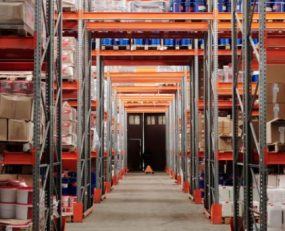
As pandemic impacts on the logistics industry gradually start to show signs of slowing down, the lasting devastation it has left on the global supply chain (GSC) is evident. Warehousing space is at an all-time low, driven by high demand across many regions, with both the UK and US seeing record demand for warehousing space in 2021. Industry drivers of this demand have been the global supply chain crisis as well as the enduring boom of the e-commerce market. The global supply chain crisis affected all parts of the logistics industry; driver and labour shortages, port blockages and high consumer demand all contributed to a system already on its knees thanks to more bureaucracy, political tensions as well as fuel price hikes.
The emergence of the e-commerce market during the pandemic as a major player and factor in the GSC had a key role in the warehousing shortages we currently are witnessing. The UK in particular has seen a double hit of warehousing issues as companies respond to the growth in the e-commerce market driven mainly through the exponential growth of Amazon, but also as they prepared for the disruption that new Brexit regulations would have starting from January 1 2022. This has had a knock-on effect on distribution network with many European companies purchasing warehousing space nearer to the UK (such as Nippon Express, GEODIS, SEGRO, and DSV), in an attempt to keep costs as low as they can be.
According to the ONS, November figures for online retail sales were 21.6% higher than November 2019, providing evidence for the growth in e-commerce. 2021 has also seen 50.7m sq ft of large distribution warehouses purchased or rented, an increase of 3.6% from 2020. The demand for the warehousing space is clear to see and a key part of the supply chain problem is that the demand is not being met by warehousing storage availability. In the UK alone, available warehousing space fell below 50m sq ft for the first time since the financial crisis of 2008/2009. This drop is attributed to the growth of requested warehouse space in e-commerce and parcels segments, rising from 6m sq ft of space between 2015-2019, to requiring a minimum of 15m sq ft annually since then.
Across the Atlantic, the US are also severely struggling with their warehousing. Bottlenecks at ports, in particular the San-Pedro Complex of the Port of Los Angeles and the Port of Long Beach, has seen great delays as shipments are unable to be moved fast enough, naturally causing this to have an impact on warehousing. CBRE, an American real estate and investment firm, have US warehousing vacancies as low as 3.6%, equating to 300m sq ft of actual warehousing space. The Port of Los Angeles itself has a record capacity of lower than 1%. Craig Fuller of FreightWaves, a global logistics data and analytics company, states “In an efficient supply chain, you want 15% availability of warehouse capacity…at 3.6% these warehouses are operating beyond their available capacity to even function properly.”. This is a poignant reminder of the importance of the warehouses for efficiency and all-round working of the logistics process.
How do we fix this problem and recover? One solution is targeting the warehousing labour shortages. Employing more staff to handle the increased numbers of goods from the increased demand would ensure a more efficient utilisation of the resources at warehouses, meaning products are stationary for less time. Driver shortages play a role here, with more drivers meaning more available trucks for carrying stocks of goods, again decreasing the amount of time products will be stationary at a warehouse.
Technology poses various opportunities to aid and overcome the problems faced. Automated warehouses are becoming increasingly popular amongst major players in a bid to help improve handling times. Automated paperwork services and pre-determined checks for imported and exported goods have the ability to ease complications at customs, reducing bottlenecks at ports as well as helping sort goods into more efficient locations (such as regional delivery sections of warehouses), helping other points of the supply chain.
An EVOX fulfilment report stated that 46% of warehousing errors are human error, supposedly costing the warehousing and retail industry up to $1.75tn in lost revenue. Automation can clearly make a difference here and reduce this figure. Furthermore, the additional revenue this would create in warehousing systems across the world would greatly impact the ability to reinvest in other processes which would help tackling the shortage of space. Improved inventory management has led to faster B2C times. Digital databases such as Internet of Things (IoT) are now commonplace in warehouses for managing stock. Deliveries through alternative methods such as drones and automated vehicles have been freeing up more truck space for other deliveries, making items leave the warehouse quicker thus reducing the volume of goods in storage spaces.
These recovery methods are becoming more widespread amongst LSPs, with UPS, DSV and GEODIS the frontrunners regarding investment in innovative warehousing technology. The key for all companies now is the speed of goods handling. As reflected, warehouse efficiency is essential for the function of the GSC, only going to show how all points are interconnected with one another. Once companies have cracked technology by means of balancing maximum capacity with maximum output, warehouses will start to free up space. There is, however, still a long road ahead.
Source: Transport Intelligence, February 15, 2022
Author: Alex Bullard